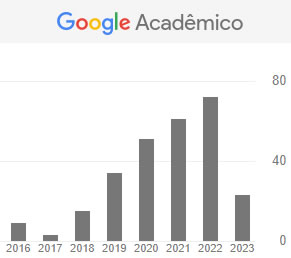Videoaula regionalizada: uma ferramenta didática no processo de ensino do princípio fundamental da contagem
DOI:
https://doi.org/10.5965/2357724X12222024e0109Palavras-chave:
tecnologias de informação e comunicação, videoaula, educação matemática, análise combinatóriaResumo
Este artigo apresenta um recorte de uma pesquisa de graduação cujo objetivo é analisar a respeito da produção de uma videoaula com temas regionalizados sobre um conteúdo de Análise Combinatória, tendo em vista sua utilização como um instrumento de ensino dentro e fora da sala de aula. Essa produção é uma continuação do Projeto VideoMat, do PIBID/IFPA/Campus Belém. O estudo foi estabelecido sobre os referenciais teóricos de Etnomatemática e Tecnologias de Informação e Comunicação, como: D’Ambrósio (2002; 2009), Ponte (1995; 2000), Moran (1995), entre outros. Essa base teórica com o apoio do PIBID permitiu a produção de uma videoaula regionalizada de qualidade alta, gravada no principal ponto turístico do Pará (Ver-o-peso), com linguagem, situações, trilha sonora tipicamente paraenses, fazendo com que o (futuro) aluno perceba os conteúdos mais próximos de sua realidade, com mais significado; promovendo a melhor fixação dos assuntos trabalhados, podendo ter acesso quantas vezes, onde e quando quiser. Essa videoaula está disponível no Youtube, podendo ser usada tanto por professores, como uma ferramenta de ensino, como por estudantes. Assim, esperamos contribuir para que os profissionais da área da educação possam se apropriar deste produto educacional a fim de proporcionar uma educação mais qualificada, com mais significado e que prepare para a vida em uma sociedade a qual está cada vez mais tecnológica.
Downloads
Referências
BRASIL. Ministério da Educação. Base Nacional Comum Curricular: proposta preliminar: terceira versão. Brasília, DF: MEC, 28 jan. 2018. Disponível em: http://basenacionalcomum.mec.gov.br/images/BNCCpublicacao.pdf. Acesso em: 15 mar. 2018.
BRASIL. Secretaria de Educação Fundamental. Parâmetros Curriculares Nacionais: terceiro e quarto ciclos do ensino fundamental: matemática. Brasília, DF: Secretaria de Educação Fundamental, 1998.
CARNEIRO, V. O educativo como entretenimento na TV cultura: Castelo Rá-Tim-Bum, um estudo de caso. 1997. Tese (Doutorado em Educação) – USP, São Paulo, 1997.
D’AMBRÓSIO, U. A matemática nas escolas. Educação Matemática em Revista, São Paulo, ano 9, p. 29-33, mar. 2002. Edição especial.
D’AMBRÓSIO, U. Educação Matemática: da teoria à prática. 17. ed. Campinas. Papirus, 2009.
FERNANDES, M. B. M. O Pará que «Treme»: Compreendendo o Tecnobrega como Património Cultural Imaterial. CEM Cultura, Espaço & Memória, [s. l.], n. 11, p. 284-293. 2021.
FIORENTINI, D. Alguns modos de ver e conceber o ensino da matemática no Brasil. Zetetiké, Campinas, n. 4, p. 1-37, nov. 1995.
IPHAN - Instituto do Patrimônio Histórico e Artístico Nacional. Brasília, DF: Iphan, 2018. Disponível em: http://portal.iphan.gov.br/pagina/detalhes/828#:~:text=Inaugurado%20em%201901%2C%20com%20o. Acesso em: 17 mar. 2018.
LEITE, W. S. S; RIBEIRO, C. A. N. A inclusão das TICs na educação brasileira: problemas e desafios. Revista Magis Internacional de Investigación en Educación, Bogotá, v. 5, n. 10, p. 173-187, 2012. Disponível em: http://www.redalyc.org/articulo.oa?id=28102489601. Acesso em: 24 jan. 2018.
MENDES, A. TIC – Muita gente está comentando, mas você sabe o que é? In: Portal iMaster, [s.l.] mar. 2008. Disponível em: http://imasters.com.br/artigo/8278/gerencia-de ti/tic-muita-gente-esta-comentando-mas-voce-sabe-o-que-e/. Acesso em: 14 fev. 2018.
MIRANDA, G. L. Limites e possibilidades das TIC na educação. Sísifo: Revista de ciências da educação, [s. l.] n. 03, p. 41-50, maio/ago. 2007.
MORÁN, J. M. O vídeo na sala de aula. Comunicação & Educação, São Paulo, n. 2, p. 27–35, 1995.
ONU. Sustainable development goal 4: educação de qualidade. Brasília, DF: Onu Brasil, 2018. Disponível em: https://brasil.un.org/pt-br/sdgs/4. Acesso em: 17 mar. 2018.
PONTE, J. P. Tecnologias de informação e comunicação na educação e na formação de professores: Que desafios? Revista Iberoamericana de Educación, Madri, v. 24, p.63-90, 2000.
PONTE, J. P. Novas tecnologias na aula de Matemática. Revista Educação e Matemática: n. 34. Lisboa: Ed. APM, 1995.
ROSENBLATT, V. Tecnobrega - The Religion of Soundsystems. Vincent Rosenblatt. 2017. Disponível em: https://vincentrosenblatt.photoshelter.com/image/I0000RafUmRcrpCc. Acesso em: 10 mar. 2024.
SILVA, G. M. Vídeo Aula: ferramenta pedagógica no ensino da matemática no subprojeto Matemática, do PIBID/IFPA/Campus Belém. Monografia (Licenciatura em Matemática) – IFPA, Belém. 2016.
SMOLE, K. S.; DINIZ, M. I. Matemática ensino médio. 6 ed. São Paulo: Saraiva, 2010.
Downloads
Publicado
Como Citar
Edição
Seção
Licença
Copyright (c) 2024 Revista BOEM

Este trabalho está licenciado sob uma licença Creative Commons Attribution-NonCommercial-NoDerivatives 4.0 International License.
Declaração de Direito Autoral
Os artigos publicados pela Revista BOEM são de uso gratuito, destinados a aplicações acadêmicas e não comerciais. As/os leitoras/es são livres para transferir, imprimir e utilizar os artigos publicados na Revista BOEM, desde que sempre haja menção explícita ao/s autor/es e à BOEM e que não haja qualquer alteração no trabalho original.
Todos os direitos autorais são atribuídos à revista BOEM. Ao submeter um artigo à Revista BOEM e tê-lo aprovado, as/os autoras/es concordam em ceder, sem remuneração, os direitos autorais à revista BOEM e a permissão para que a revista BOEM redistribua esse artigo e seus metadados aos serviços de indexação e referência que seus editores julguem apropriados.
Os artigos cujos autores são identificados representam a expressão do ponto de vista de seus autores e não a posição oficial da Revista BOEM.
O BOEM adota a licença Creative Commons - Atribuição-Não Comercial-Sem Derivações 4.0 Internacional.




